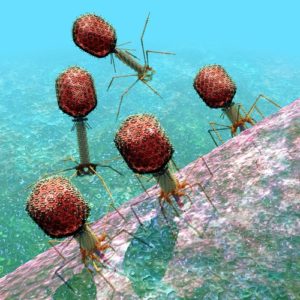 Jumping genes and viruses are drivers of evolution.
Jumping genes and viruses are drivers of evolution.
Bacteria show many cognitive processes.
Bacteria shed unnecessary functions forming symbioses to save energy, or to give energy.
Giant viruses show that viruses could have evolved from bacteria by shedding functions, but still having microbe intelligence.
Are viruses the smallest living particles with cognitive abilities.
But, viruses are just a piece of DNA or RNA!
Viruses transfer significant sections of DNA to and between bacteria and eukaryote human cells. Like jumping genes, much of the genome of most creatures is DNA from viruses. These DNA transfers from viruses and jumping genes are the meat of evolution. These sections of DNA, either altered from jumping genes or taken from a virus, produce specific new 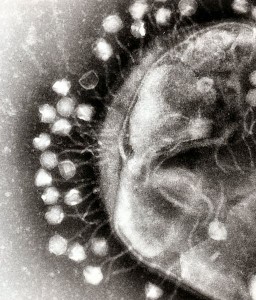 protein shapes that allow new functions in evolution.
protein shapes that allow new functions in evolution.
Our understanding of the place of viruses in evolution and in the tree of life is still evolving. A new finding of very large giant viruses changes the view of what viruses are and have been. Most probably many evolved from microbes with the same cognitive function as bacteria only cleverly using other cells for much of their machinery, making them lighter and faster, and in some ways more powerful.
Cognitive Function in Cells and In Viruses.
A previous post discussed some of the many unusual capacities of viruses. But, recent changes in our understanding of genetics from ENCODE and jumping genes makes us re evaluate the editing features of viruses that are similar to critical functions in all cells.
 Cells have editing processes to correct copying errors of DNA sequences, to produce alternative RNA transcripts from a wide range of DNA, to cut and sew copies of jumping genes in and out of the chromosome, and for a virus to plant its DNA or RNA load and copy the necessary structure to make more viruses. The elaborate cellular cognitive processes of all of this editing appears very similar. Somehow, the viruses, also, know how to do this, even they are basically only a piece of DNA or RNA.
Cells have editing processes to correct copying errors of DNA sequences, to produce alternative RNA transcripts from a wide range of DNA, to cut and sew copies of jumping genes in and out of the chromosome, and for a virus to plant its DNA or RNA load and copy the necessary structure to make more viruses. The elaborate cellular cognitive processes of all of this editing appears very similar. Somehow, the viruses, also, know how to do this, even they are basically only a piece of DNA or RNA.
For this reason as well as others, it is thought that viruses were once cells that gave up unnecessary function. Or, viruses have the same cellular cognitive abilities without ever having been cells.
Virus Most Active Life Form
Most of life on earth is in the form of microbes and viruses outnumber microbes ten to one. Viruses are the most genetically diverse biological group. Phages diversity alone (virus that do commerce with bacteria) is enormous. Viruses are the least characterized part of biology and have many functions beyond just fighting with bacteria.
 Viruses kill up to 50% of the bacteria in the ocean each day, driving evolution of the bacteria and releasing huge amounts of carbon that pile up as structures near the ocean, such as the White Cliffs of Dover.
Viruses kill up to 50% of the bacteria in the ocean each day, driving evolution of the bacteria and releasing huge amounts of carbon that pile up as structures near the ocean, such as the White Cliffs of Dover.
Photosystem genes are carried by phages, as well as all the important metabolic functions. When bacteria enter a new space their viruses at times protect them. The bacteria that have been killed by the phages can have a special characteristic called “superinfection exclusion” that means a virus will attack other species of bacteria not the type they were born in.
Viruses participate in many symbioses including where bacteria produce phage virus that make specific toxins useful to the bacteria. Viruses are able to give plants the ability to handle drought, heat and cold. In Yellowstone a fungus helps grass to grown in hot soils, but cannot do this without its virus. A virus makes rye grass toxic to animals protecting the grass. In humans a new finding shows that Hep C virus uses a critical micro RNA regulatory molecule to control the hepatic cell.
Giant Viruses
Recent discoveries of extremely large viruses, as large a small cell, with a substantial amount of genetic material, have bolstered the view that viruses were once bigger cells, but learned how to thrive with less baggage.
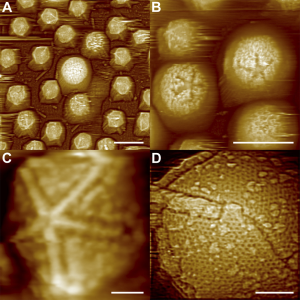 A new study looked at the three dimensional structures of viruses. They defined specific structural motifs that had to evolve over specific period of time. Protein folds appear only in specific group, and other folds are common to all, which would make them more ancient.
A new study looked at the three dimensional structures of viruses. They defined specific structural motifs that had to evolve over specific period of time. Protein folds appear only in specific group, and other folds are common to all, which would make them more ancient.
When comparing these 3D folds in bacteria, archaea, and the large viruses, it was noted that the machinery of the virus were equivalent to bacteria. Some of the new large viruses have enzymes built in. It was previously considered that only cells have enzymes, which are used by viruses. Many of the important protein folds in cells were also present in the giant viruses, implying a very early evolutionary role.
Based upon extensive analysis of the types of proteins available in all microbes a new tree of life was designed. In this new evolutionary tree, there are four branches, bacteria, archaea, eukarya (which includes plants and animals) and viruses.
In this design viruses were more dominant at one time and became less complex as they formed symbiotic relationships with cells, much the way mitochondria have accommodated to life within our cells, and have gradually needed less of their own DNA, using more of the larger cell’s genetic material for some of its functions. It is possible that the giant viruses are the oldest type and the smaller ones more recent types who have thrived under the parasitic life style. In this way viruses evolved from bacteria by gradually giving up capacities.
Intelligent Microbes
Previous posts have demonstrated many of the advanced decision making abilities of microbes. A previous post noted the unusual electrical wires and connections between microbes. A recent article in Nature elaborated the ability of microbes to send fuel in the form of electrons great 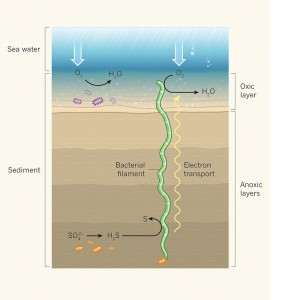 distances (centimeters) to feed an entire colony spread over great distance. This is an enormous distance when considering the scale of a microbe – essentially equivalent to a human walking the entire wall of China.
distances (centimeters) to feed an entire colony spread over great distance. This is an enormous distance when considering the scale of a microbe – essentially equivalent to a human walking the entire wall of China.
Microbes have the ability to send secretions to other comrades, especially in quorum sensing, where the group decides to change behavior when enough microbes are present. Recently, very intelligent behavior of slime molds has also been demonstrated. The molds are able to explore, using knowledge of where they have already been.
But, perhaps the most important factor in microbe communications is the transfer of DNA, that has not yet been accorded cognitive status.
With the new understanding of genetics that has occurred because of ENCODE (see post) and jumping genes (see post), it is apparent that cellular self editing is a very significant determinant of many aspects of genetics. This cellular self editing appears to involve cognitive processes.
In view of this, it is difficult to not consider the transfer of DNA by bacteria using viruses, either endogenous viruses or the ones bacteria can create themselves, as another cognitive process of bacteria.
Transfer of DNA Sections Among Microbes
DNA in the bacteria is usually in two different forms in bacteria. The major form is in circular chromosomes, without a nucleus. A second form is that of plasmids, 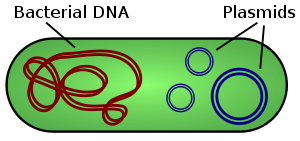 strands of DNA such as those copied by jumping genes or transmitted in viruses. These strands of DNA that are transmitted between bacteria are the new protein shapes, that have been discussed in the last two posts, (one, two). It is the shape of the strand of the DNA that allows the new structures and therefore the new functions to be passed between different bacteria.
strands of DNA such as those copied by jumping genes or transmitted in viruses. These strands of DNA that are transmitted between bacteria are the new protein shapes, that have been discussed in the last two posts, (one, two). It is the shape of the strand of the DNA that allows the new structures and therefore the new functions to be passed between different bacteria.
 It has been known for some time that bacteria have mechanisms of transferring these pieces of DNA. One is the secretion III system that looks just like a virus and basically injects the DNA into another cell. (see picture on right to compare them) There are other mechanisms of sending plasmids such as when two microbe touch.
It has been known for some time that bacteria have mechanisms of transferring these pieces of DNA. One is the secretion III system that looks just like a virus and basically injects the DNA into another cell. (see picture on right to compare them) There are other mechanisms of sending plasmids such as when two microbe touch.
But, perhaps the major way transfer occurs is by the viruses that are ubiquitous around and in bacteria, outnumbering bacteria at least 10 to one. Recently, it was shown that a pathological bacteria, faecalis, actually builds viruses themselves, and sends them to use toxins against enemies.
Less Baggage – A Microbe principle
A very clever and important characteristic of microbes is that they reduce baggage whenever they can. This has allowed them to be very good at symbiosis. For example in our eukaryote cell the mitochondria was a microbe that found it protective to live inside of a large cell. It serves a vital function in the cell producing energy. Gradually over the years it has released many of the functions to the 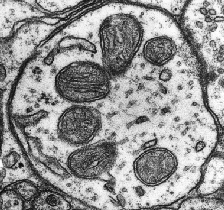 nucleus of the big cell, but keeps some of its important genes for itself. See my previous post on mitochondria in neurons to show how independent they function inside large neurons, seeking out work and multiplying wherever it is necessary in the huge neuron. Mitochondria also prune defective comrades that might cause trouble.
nucleus of the big cell, but keeps some of its important genes for itself. See my previous post on mitochondria in neurons to show how independent they function inside large neurons, seeking out work and multiplying wherever it is necessary in the huge neuron. Mitochondria also prune defective comrades that might cause trouble.
This characteristic of reducing baggage can lead to many different types of symbiosis – one where they produce energy, and ones where they benefit from taking energy. Another is transferring antibiotic resistance.
If the virus was once a bacteria it has now shed most of its extraneous functions, and lives a much more free and lively existence.
Virus Intelligence and War with Bacteria
It has been very difficult to study viruses until recently. Data is just now coming in.
Previous posts shows the surprising abilities of viruses, who seem as intelligent as some microbes, but with far less machinery. It seems as though a piece of RNA or DNA might alone be enough for intelligence and cognitive behavior.
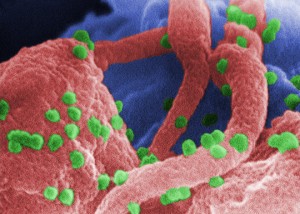 Viruses and other microbes engage in a winner take all battle for survival everywhere where there is life, including some very extreme environments where life as we know it shouldn’t survive, but does.
Viruses and other microbes engage in a winner take all battle for survival everywhere where there is life, including some very extreme environments where life as we know it shouldn’t survive, but does.
Because of the constant transfer of genes, the evolutionary history of bacteria and archaea are impossible to decipher. With rapidly changing DNA and RNA, viruses are even more difficult. Studying changes in genetic material is not sufficient to determine virus evolution.
The New Community Virus Bacteria Relationship
In the human gut adult microbe communities are stable by age three. Previously it was thought that phages would only exist in a state of battle with microbes as they do in the ocean, where half of the microbes are destroyed by viruses every day.
Another way bacteria have been known to exist with viruses is through CRISPR elements that create immunity to any new DNA that comes into a cell, such as viruses. CRISPR, Clustered Regularly Interspaced Short Palindromic Repeats, are repeated copies of strands of microbe DNA that have pieces of viruses interspersed between. Having copies of the viruses that have previously entered the cell in between the CRISPR copies serves as a way to create micro RNA that interfere with the virus – very much like our microRNA and immunity systems.
But recently a different type of relationship between virus and bacteria has been demonstrated called “temperate” rather than “lytic”. A lytic relationship is one where the virus lyses, that is, kills, the host cells once it is used.
Temperate is a different relationship where the virus and microbe form an ongoing relationship to co exist and help each other.
In the temperate relationship viruses can create chemicals that actually protect the bacteria cell. In the ocean the more a bacteria wins dominance the faster they are killed by phage.
The virus can immunize the bacteria from other phages. The phage can make new chemicals that allow the microbe to use of increased number of nutrients, provide antibiotic resistance, or kill other types of competitive bacteria. In this situation the virus either lives in the chromosome or as a plasmid.
In temperate arrangements when there is environmental stress, the phage can turn on the bacteria and become lytic again. The dead cells become food for the remaining members of the colony. In this phase, the phage may kill other bacteria and protect the host bacteria cells. In many situations when new microbes appear in a territory, the protective viruses increase DNA transfer to help their related microbes survive.
In this same helping capacity, viruses may be essential for immune function in humans. In animals many viruses are brought in with specific foods, and this may be a way that diet affects microbe populations.
Transfer of DNA Is Virus’ Most Important Function
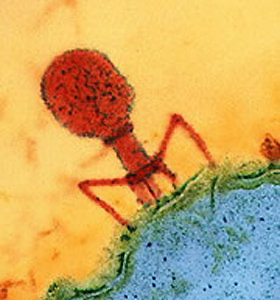 Perhaps, the most important aspect of viruses is there ability to transfer information. The entire phage structure appears to be designed to inject pieces of genetic material. This transfer ability might have evolved as the central avenue of evolution along with jumping genes and other wholesale transfer of advanced protein shapes.
Perhaps, the most important aspect of viruses is there ability to transfer information. The entire phage structure appears to be designed to inject pieces of genetic material. This transfer ability might have evolved as the central avenue of evolution along with jumping genes and other wholesale transfer of advanced protein shapes.
Those structures that the viruses share with other colony members become more widely distributed.
Bacteria Create Phages At Will
 The microbe enterococcus faecalis usually lives peacefully in the human gut. But, if it can get into the bloodstream it becomes dangerous to humans. One particular strain recently was shown to produce a large amount of phage viruses, which takes a lot of energy from the bacteria. But, it was worth it because the phages killed all other strains of faecalis that were competing for food.
The microbe enterococcus faecalis usually lives peacefully in the human gut. But, if it can get into the bloodstream it becomes dangerous to humans. One particular strain recently was shown to produce a large amount of phage viruses, which takes a lot of energy from the bacteria. But, it was worth it because the phages killed all other strains of faecalis that were competing for food.
The bacteria is so connected with their friendly viruses that they have the machinery to create them at will, as well as live in cooperation with them. At any time, however, the virus can kill the microbe, but doesn’t when there is mutual benefit.
Conclusion – Whittled Down to the Smallest Piece of Life
The movement of pieces of DNA is the commerce of evolution and life. These strands of DNA represent shapes for the interlocking machinery of proteins. The new versions of the shapes are produced in altering the many copies produced by jumping genes and by innovations brought by viruses. All of the neuron’s functions, including the influence of mental events, operate through a vast array of interlocking proteins.
 The editing functions of the cell are similar for the operations of the virus and the jumping gene. Both have strands of DNA that are cut out and sewn in. RNA, somehow, performs editing functions by splicing together pieces of DNA to make the transcripts including many alternative splices. Complex cellular self editing corrects any errors in the copying of DNA (see post). All of this intelligent cellular editing is somehow directed by the vast regulatory network discovered by ENCODE, such as microRNA, and millions of protein switches and transcription factors.
The editing functions of the cell are similar for the operations of the virus and the jumping gene. Both have strands of DNA that are cut out and sewn in. RNA, somehow, performs editing functions by splicing together pieces of DNA to make the transcripts including many alternative splices. Complex cellular self editing corrects any errors in the copying of DNA (see post). All of this intelligent cellular editing is somehow directed by the vast regulatory network discovered by ENCODE, such as microRNA, and millions of protein switches and transcription factors.
Bacteria have many remarkable properties. They can communicate to perform group events, and produce extremely long wires to chemically support each other. Bacteria can also utilize their editing and communication skills to send a virus particle using a secretion system, or manufacture a real virus, delivering genetic information on photosynthesis, antibiotic resistance and metabolism.
Viruses are basically just a piece of DNA or RNA that makes a protein coat, but appears to have the same cognitive skills of a bacterial cell, probably, in fact, being an old bacteria that whittled down its needs to the bare minimum becoming the smallest particle showing cognitive ability.
Viruses are equivalent to jumping genes. Both utilize the intelligent cellular editing and have similar cognitive skills. Viruses know how to utilize both elaborate bacterial and animal genetic machinery.
Can we, therefore, say that a strand of DNA or RNA alone can have cognitive ability?